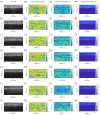High-frequency quantitative ultrasound in characterizing human skin aging: an exploration of the non-modeling and modeling approaches
- PMID: 40727367
- PMCID: PMC12290714
- DOI: 10.21037/qims-24-1753
High-frequency quantitative ultrasound in characterizing human skin aging: an exploration of the non-modeling and modeling approaches
Abstract
Background: High-frequency quantitative ultrasound (HQUS) technology, with its non-invasiveness, high-resolution, objectivity, and reproducibility, holds significant potential for characterizing skin aging through the analysis of the internal structure of tissues. This study aims to explore a framework for characterizing skin aging assessment through HQUS technology to facilitate the subsequent analysis of skin aging-related studies.
Methods: In this study, an exploration of non-modeling and modeling HQUS techniques in characterizing skin aging was conducted. In particular, we tested the conventional approach using the envelope amplitude, the non-modeling approach based on the small-window entropy and the modeling approach with the Nakagami parameters (m and Ω) at scanning depths of 1 and 1.5 mm, respectively, and discovered that such a characterization framework is well-suitable for quantifying skin aging. These parameters were calculated based on ultrasound backscattered signals at a high frequency of 42 MHz from the facial skin (from the epidermis to the dermis) of 70 female participants aged 24-57 years and then analyzed using the linear fitting and receiver operating characteristic (ROC) curves.
Results: The results show that there exists a linear correlation between all parameters and participant ages at scanning depths of 1 and 1.5 mm, respectively. Among them, the correlation coefficients for parameter m are r2=0.84 (P<0.0001) and r2=0.65 (P<0.0001), which are higher than those for the relative envelope amplitude, small-window entropy, and parameter Ω. Moreover, the parameter m also has the highest area under the curve among the ROC curves, regardless of the scanning depth.
Conclusions: This characterization framework, especially the modeling of the Nakagami parameter m, has great feasibility for the characterization of human skin aging. The proposed framework holds significant potential for assessing the efficacy of facial rejuvenation products, photofacials, and similar treatments.
Keywords: Nakagami parameter; Skin aging; envelope amplitude; high-frequency ultrasound; small-window entropy.
Copyright © 2025 AME Publishing Company. All rights reserved.
Conflict of interest statement
Conflicts of Interest: All authors have completed the ICMJE uniform disclosure form (available at https://qims.amegroups.com/article/view/10.21037/qims-24-1753/coif). Y.L. reports the funding from the Yunnan University Professional Degree Graduate Practical Innovation Fund Project (No. ZC-23233850). B.H. reports the funding from the National Natural Science Foundation of China (Nos. 62003298, 62201495, and 62261057) and is an employee of Yunnan Betani Biotechnology Group Co., Ltd. X.L. reports the funding from Yunnan Province “Foster Yunnan Talent Support Program” Youth Talent Special Project (No. C6213001204). N.Z., Z.G, and Y.Z. are employees of Yunnan Betani Biotechnology Group Co., Ltd. The other author has no conflicts of interest to declare.
Figures








Similar articles
-
Systemic pharmacological treatments for chronic plaque psoriasis: a network meta-analysis.Cochrane Database Syst Rev. 2021 Apr 19;4(4):CD011535. doi: 10.1002/14651858.CD011535.pub4. Cochrane Database Syst Rev. 2021. Update in: Cochrane Database Syst Rev. 2022 May 23;5:CD011535. doi: 10.1002/14651858.CD011535.pub5. PMID: 33871055 Free PMC article. Updated.
-
Comparison of Two Modern Survival Prediction Tools, SORG-MLA and METSSS, in Patients With Symptomatic Long-bone Metastases Who Underwent Local Treatment With Surgery Followed by Radiotherapy and With Radiotherapy Alone.Clin Orthop Relat Res. 2024 Dec 1;482(12):2193-2208. doi: 10.1097/CORR.0000000000003185. Epub 2024 Jul 23. Clin Orthop Relat Res. 2024. PMID: 39051924
-
Systemic pharmacological treatments for chronic plaque psoriasis: a network meta-analysis.Cochrane Database Syst Rev. 2020 Jan 9;1(1):CD011535. doi: 10.1002/14651858.CD011535.pub3. Cochrane Database Syst Rev. 2020. Update in: Cochrane Database Syst Rev. 2021 Apr 19;4:CD011535. doi: 10.1002/14651858.CD011535.pub4. PMID: 31917873 Free PMC article. Updated.
-
Systemic pharmacological treatments for chronic plaque psoriasis: a network meta-analysis.Cochrane Database Syst Rev. 2017 Dec 22;12(12):CD011535. doi: 10.1002/14651858.CD011535.pub2. Cochrane Database Syst Rev. 2017. Update in: Cochrane Database Syst Rev. 2020 Jan 9;1:CD011535. doi: 10.1002/14651858.CD011535.pub3. PMID: 29271481 Free PMC article. Updated.
-
[Volume and health outcomes: evidence from systematic reviews and from evaluation of Italian hospital data].Epidemiol Prev. 2013 Mar-Jun;37(2-3 Suppl 2):1-100. Epidemiol Prev. 2013. PMID: 23851286 Italian.
References
-
- Richard S, de Rigal J, de Lacharriere O, Berardesca E, Leveque JL. Noninvasive measurement of the effect of lifetime exposure to the sun on the aged skin. Photodermatol Photoimmunol Photomed 1994;10:164-9. - PubMed
LinkOut - more resources
Full Text Sources
